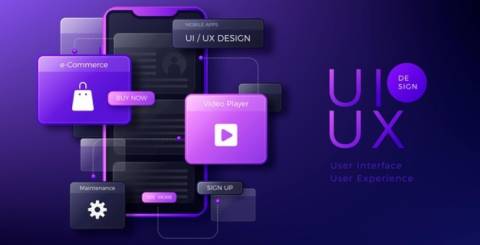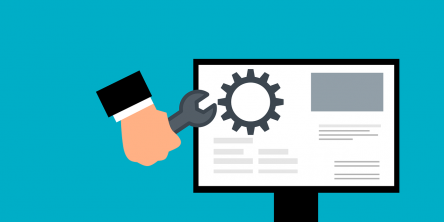How To Design An App? – A Brief

Interactive designs and excellent user interface (UI) are required to stand out in the Apple AppStore and Google Play Store. Of course, launching a visually appealing app is not a simple task because of the sheer number of people who use them.
As soon as you've decided to construct an app, you must come up with something unique that sets you apart from your competitors. So, here is the answer to your question: how do I design an app effectively? Follow this guide to learn more.
1. Defining your app's purpose and budget
It's best to start with a pen and paper rather than rushing to the computer. Consider why you're creating the app and what you want to achieve. The importance of goal setting extends beyond app design; it's a life lesson!
To stay on track, it is essential to write down all of your app's objectives and have them in front of you at all times. Writing them down will be an excellent reference to keep you on track and pace for app global conquest if you ever forget one of these questions.
The budget you set for the app's development and design and the value it will provide to your company are all critical factors to keep in mind. Remember to estimate the mobile app design cost to avoid any financial problems in the future.
2. Create a strategy for success
Visualize your responses to the questions you asked yourself while making goals and write them down. To begin, consider the answers to your first inquiries. Outline your project's scope using this new information. There are several ways in which you might monetize your app at this stage (advertising, in-app purchases, etc.).
You can also sketch out a plan for how you want to implement your ideas in the app. A road map of your app's functionalities, target audience, and how to get there is what this stage is all about creating.
3. Do some market and competition research
Find out what users are looking for and how your app may help them. Research is an essential part of app development. It's critical to know your app's target audience and acquire a sense of the competition.
Take nothing you perceive as a threat. It doesn't imply your app won't be the one to beat just because there are a lot of identical ones out there. Investigating the applications of your rivals can offer you a better idea of what you should include in your own.
Try to pay attention to the reviews of the applications already out there and see what people are saying about them. Is there anything you can do to help them? It's also an excellent time to go through your written and drawn notes to see any changes you can make.
4. Create an app wireframe
The visual architecture of your app is established in your wireframe. A basic "blueprint" of the design and functionality of your app will be created when you've completed your goals-and-sketches phase.
In the beginning, you can accomplish this on paper, but if your wireframes get more complex and comprehensive, using digital tools is much more convenient.
Gather your coworker’s and friends’ input on your app's structure and navigation by showing them your wireframes. Find out whether your testers can use the app without difficulty.
A simple wireframe adjustment and a new round of testing will let you fix any problems with your navigation or reorganize screens and layout as needed. To get the best results from your wireframes, keep moving back and forth.
5. Design your app
Creating high-quality, realistic prototypes of your app's design are now necessary. Don't scrimp on the design of your app since it's what your users will remember for the rest of their lives. Having a gorgeous, professional-looking design is the key to making your app a huge success.
Colors, typefaces, and other design aspects are a huge choice. To ensure that you obtain the best possible outcome, it's best to work with an expert designer.
6. Collect input on your design via surveys or focus groups
It's time to get your friends, family on board and put your app through its paces. This can be done quickly using a rendered click-through model, which will offer your testers a sense of what the app would be like.
You should keep in mind that this is not the final version of your software and that there will be further testing in the future. This is just a look-and-feel test; the functionality will be added later.
Once you've gathered all the information you want and have a firm grasp on what's working and what needs better, you can return to your designer and request that they make the required changes.
7. Develop your app
Having completed your design, it's now time for you to send it over to your development team. To ensure that your software functions as it should, they'll write the code for the app's functional side. Most likely, they'll communicate back and forth with you and your designer during the development process to make adjustments to the design and resolve any difficulties they encounter.
8. Test your app
Be willing to accept constructive feedback to make the final improvements to your application. Now that we have a completely functional app, you'll want to check it's precisely that before putting it out there. Every part of the app must be fully functional and aesthetically attractive.
Do you recall the ecstatic volunteers who assisted you in the first testing of your mockups? Re-contact such individuals. Make them a test group and give them complete control over your app's features.
Before making a final decision, acquire as much input as possible. You may use the constructive feedback you get from a designer and developer to help improve the final product by incorporating it into the design and development process.
9. Launch a test version
To do beta testing, you must make a limited number of copies of your program accessible to a select group of early adopters. You'll be able to see how your app performs in a real-world setting and see how consumers react to it.
There will come the point when your app is ready for public display when you've gathered all the feedback you need and have performed a thorough study of how your app appears and operates in a natural setting.
10 . Launch your app
Finally, there's a glimmer of hope! Your app is now ready for sale after months of development and testing. Before introducing an Android app, there is no need for a review. To get your app out to the public, all you have to do is publish your app file to the Google Play store (like you did with the beta version).
With iOS, you have to submit your app for approval before it can be released. Getting the go-ahead should be a piece of cake if you've followed our comprehensive advice and done everything right.
Don't just sit on your laurels now that the whole public has access to your app. Your app should be constantly improved and updated to provide your customers with the best possible experience.
Also, don't overlook the significance of the next stage, namely, marketing. Getting your app into the hands of your customers will be easier if you market it well.
Final words
In today's corporate environment, apps are so prevalent. You are now prepared to build an app that will grab people's attention. If you follow this method and split the app design process into minor, manageable phases, it will become a lot simpler.
Similar Articles
The broad spectrum of industries across the globe is under unprecedented pressure to optimize their operations. And maximize profits, of course. The rise of cloud computing, particularly platforms such as Microsoft Azure, has created incredible opportunities. Unfortunately, it has also made managing IT spending a tad complex
Global markets are becoming more interconnected and quite evidently at that. The result? Shorter product lifecycles have led to unprecedented pressure for businesses to optimize operations. And maintain a competitive advantage, of course.
Using the power of big data analytics can change the way businesses operate. Analysis of large datasets lets companies gain detailed information about their customers and markets, allowing them to remain competitive.
The market is brimming with all sorts of software solutions and whatnot. Yet, software as a service has managed to establish itself as the dominant software delivery model. Businesses are now increasingly switching to cloud apps to improve efficiency and drive innovation. And embracing SaaS is driving an increase in demand for adaptable and scalable software solutions
The global conveyor system market, valued at $6.4 million in 2024, is likely to reach $11 million by 2034.
Content has permanently changed. We essentially have the digital revolution to thank for it. You see, how content is created and consumed has been fundamentally transformed.
Explore how enterprise software simplifies complex testing with secure, scalable solutions, streamlining exam creation, administration, and data management for institutions.
Using fiber optic technology, HDMI cables can transmit video and audio signals without compromising on quality over extensive distances.
Explore the OSFP transceiver: a high-speed, future-ready solution for data centers. Learn its advantages in bandwidth, thermal performance, and signal integrity.









